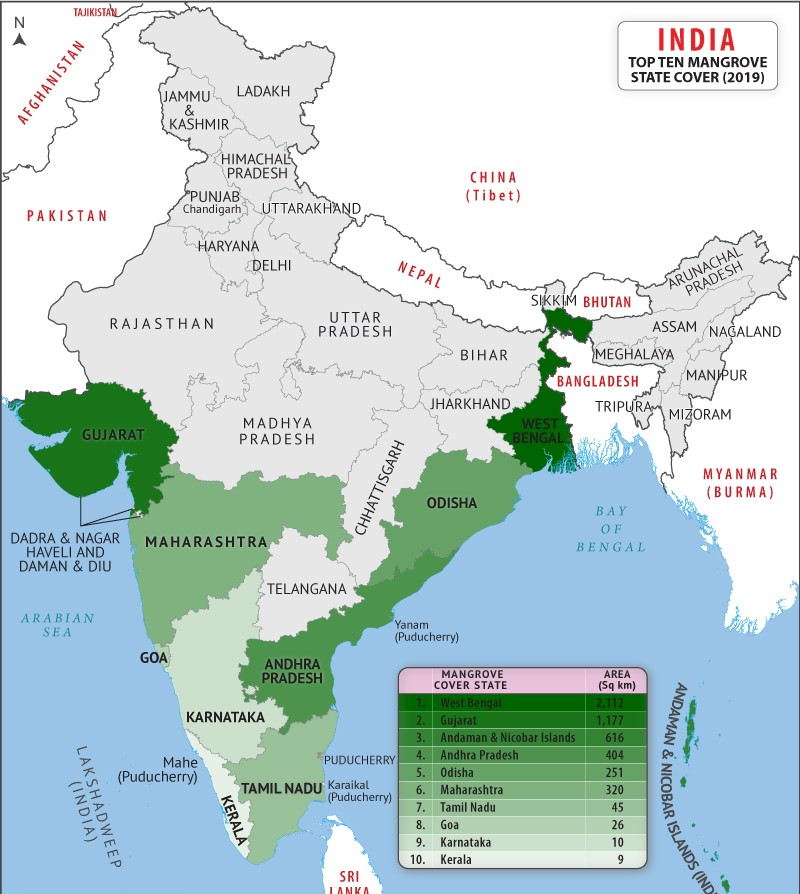Biodiversity & Environment
Loss of Mangrove Cover on Katchal Island
- 12 Aug 2022
- 7 min read
For Prelims: National Aeronautics and Space Administration (NASA), Nicobar archipelago, Mangrove cover
For Mains: Significance of Mangroves ecosystem
Why in News?
Recently, a study by the National Aeronautics and Space Administration (NASA), highlighted the loss of mangrove cover on Katchal island, part of India’s Nicobar archipelago.
- It showed the extent to which mangroves had been lost globally over the past two decades.
What are Mangroves?
- About:
- Mangroves are tropical plants that are adapted to lose, wet soils, salt water, and being periodically submerged by tides.
- Features:
- Saline environment: They can survive under extreme hostile environments such as high salt and low oxygen conditions.
- Low oxygen: Underground tissue of any plant needs oxygen for respiration. But in a mangrove environment, the oxygen in soil is limited or nil.
- For the purpose of breathing, they develop special roots called pneumatophores.
- Survival in Extreme Conditions: With their roots submerged in water, mangrove trees thrive in hot, muddy, salty conditions that would quickly kill most plants.
- Viviparous: Their seeds germinate while still attached to the parent tree. Once germinated, the seedling grows into a propagule.
- A propagule is a vegetative structure that can become detached from a plant and give rise to a new plant. Examples include a bud, sucker, or spore.
- Significance:
- Mangroves trap and cycle various organic materials, chemical elements, and important nutrients in the coastal ecosystem.
- They provide one of the basic food chain resources for marine organisms.
- They provide physical habitat and nursery grounds for a wide variety of marine organisms, many of which have important recreational or commercial value.
- Mangroves also, serve as storm buffers by reducing wind and wave action in shallow shoreline areas.
- Area Covered
- Global Mangrove Cover:
- The total mangrove cover in the world is one 1,50,000 sq kms.
- Asia has the largest number of mangroves worldwide.
- South Asia comprises 6.8% of the world's mangrove cover.
- Indian Mangrove Cover:
- India's contribution is 45.8% total mangrove cover in South Asia.
- According to the Indian State Forest Report 2021, Mangrove cover in India is 4992 sq. Km which is 0.15% of country’s total geographical area.
- Largest Mangrove Forest: Sundarbans in West Bengal are the largest mangrove forest regions in the world. It is listed as a UNESCO World Heritage Site.
- The forest is home to the Royal Bengal tiger, Gangetic dolphins and Estuarine crocodiles.
- Bhitarkanika Mangroves: The second largest mangrove forest in India is Bhitarkanika in Odisha created by the two river deltas of River Brahmani and Baitarani.
- It is one of the most significant Ramsar wetlands in India.
- Godavari-Krishna Mangroves, Andhra Pradesh: The Godavari-Krishna mangroves extend from Odisha to Tamil Nadu.
- Global Mangrove Cover:
What are the Key Highlights of the Study?
- The study shows the real extent of tidal wetlands lost between 1992 and 2019 on Katchal Island in the Nicobar Islands in the eastern Indian Ocean.
- The mangroves had the highest ratio of loss to gain among the three types of tidal wetlands it studied.
- The other two were tidal flats and marshes.
- Mangroves showed an estimated net decrease of 3,700 square kilometers between 1999 and 2019.
- Despite the losses, there have been gains of 2,100 square kilometers indicating the considerable dynamism of these systems.
- Reasons for loss:
- Natural cause:
- There was an earthquake with a magnitude of 9.2 during the Tsunami of 2004, during which the islands experienced up to 3 meters (10 feet) of land subsidence.
- This submerged many mangrove ecosystems, resulting in a loss of more than 90% of mangrove extent in some areas.
- There was an earthquake with a magnitude of 9.2 during the Tsunami of 2004, during which the islands experienced up to 3 meters (10 feet) of land subsidence.
- Other Factors:
- Sea level rise, shoreline erosion, storms, altered sediment flow, and subsidence.
- Natural cause:
- Human Induce:
- Some 27% of the losses and gains were directly caused by human activity.
- They alter wetlands through development, water diversion projects, or by converting the land to agriculture or aquaculture.
- Some 27% of the losses and gains were directly caused by human activity.
- Present Status:
- It's very difficult that the earlier mangrove cover will ever come back but there has been a rise in their numbers in other places since they propagate themselves through propagules.
Way Forward
- Conservation needs to be linked with a broader perspective with active community involvement, environmental security, and reducing any risks from natural calamities.
- Such measures need to be adopted more holistically in view of anticipatory adaptation measures which hold the clue for successful and effective management.
UPSC Civil Services Examination Previous Year Question (PYQ)
Prelims
Q. Which one of the following regions of India has a combination of mangrove forest, evergreen forest and deciduous forest? (2015)
(a) North Coastal Andhra Pradesh
(b) South-West Bengal
(c) Southern Saurashtra
(d) Andaman and Nicobar Islands
Ans: (d)
Exp:
- North coastal Andhra Pradesh has mangroves and dry evergreen forests.
- South West Bengal has mangroves and evergreen forests.
- Southern Saurashtra has mangroves, dry deciduous, tropical thorn forests etc.
- The tropical islands of Andaman and Nicobar have a combination of mangrove forests, evergreen forests and deciduous forests.
- Therefore, option (d) is the correct answer.
Mains
Q. Discuss the causes of depletion of mangroves and explain their importance in maintaining coastal ecology? (2019)







